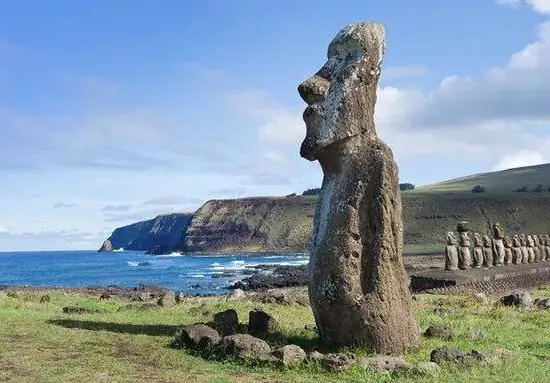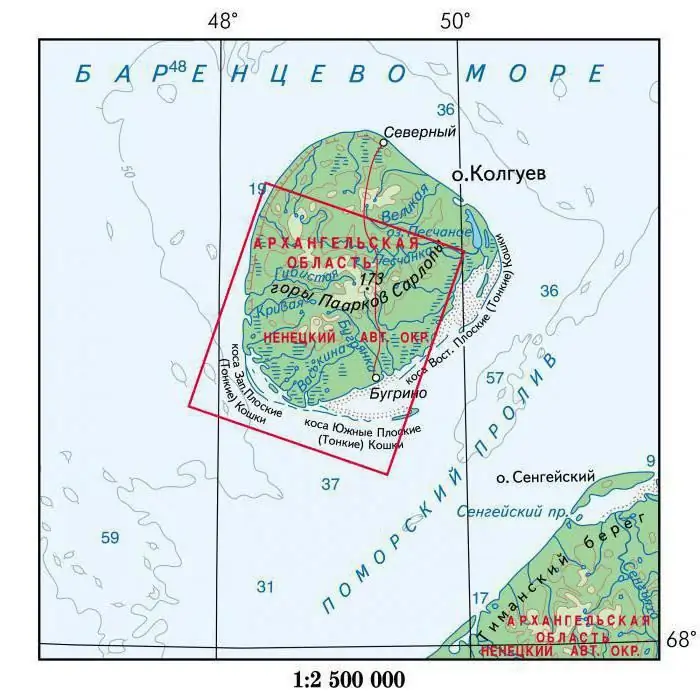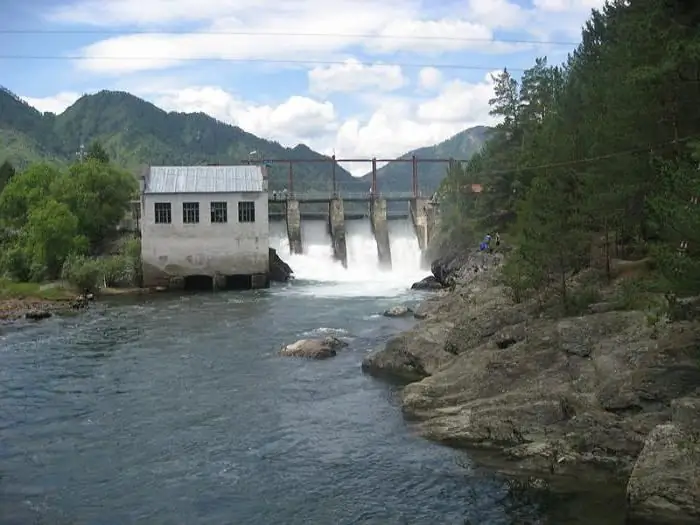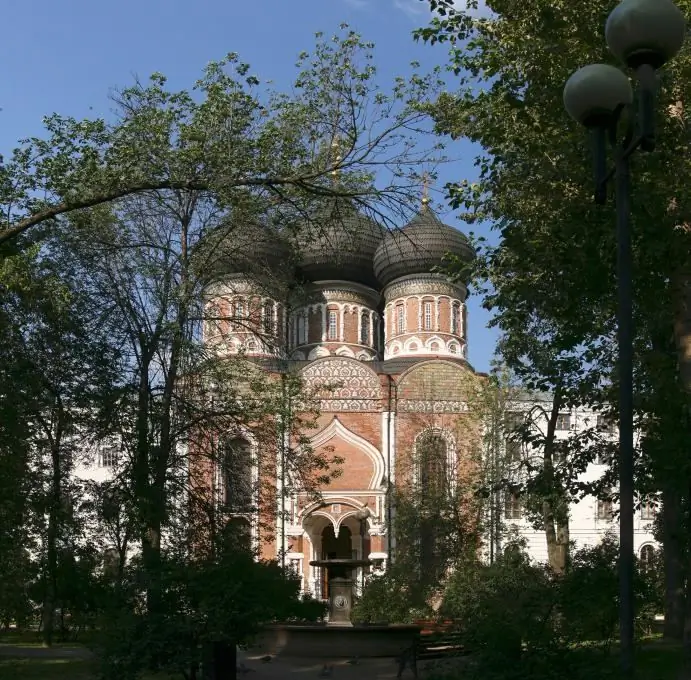- Author Harold Hamphrey [email protected].
- Public 2023-12-17 10:06.
- Last modified 2025-01-24 11:10.
On the map of our country, this small island is almost invisible - it is a small piece of land on the border of Asia and Europe. Like a deadbolt, it securely locks the entrance to the "ice bag" of the Kara Sea, bounded from the north by the Novaya Zemlya archipelago, and from the south by the Yugra Peninsula.

Geographic location
First, you should decide where Vaygach Island is located. This northern land is located between the Barents and Kara Seas. Vaigach Island is separated from the continent by a small strait called Yugorsky Shar, and from Novaya Zemlya by the Kara Gate Strait.
The total area of the territory is 3.4 thousand square kilometers. The surface is mostly flat, with two parallel ridges up to 157 m high.

History
The pioneers of Vaigach Island are representatives of the peoples of the north - Yugra and Samoyeds (or Samoyeds). Later, the Russians came here, but there is no documentary evidence of their first visits to this land. Only at the end of the 16th century were the testimonies of European sailors who met in these placesPomors (Russians) and Nenets.
At the end of the 15th century (1594), an expedition from Holland was looking for a new, shorter route to India and China. Navigators explored Vaigach Island and found more than 400 idols on the cape. It later became known as the Cape of Idols.
Before the revolution, the first polar station was built on the island, and a little later a radio station appeared. During the Soviet years, several Nenets families were resettled on Vaygach Island.

In 1931, exploration and development of lead-zinc ore, the main we alth of Vaygach Island, began. At that time, lead and zinc mines functioned here. In the south of the island, the remains of flooded mines, rusted rails and trolleys have survived to this day.
And more recently, archaeologists have discovered unique finds (which, by the way, date back to the 3rd century BC), indicating human life in this territory, although this was much earlier than the settlement of the island by the Nenets.
On the origin of the relief of Vaygach Island
This territory is characterized by a calm relief, which is disturbed in the Kara Gate, where there are basins of tectonic origin. Basically, the relief of the plateau is flat, prepared surfaces, which are composed of strong pre-Quaternary rocks. They are practically devoid of loose cover.
The bedrock rocks are mostly shallow. On the territory of flooded lacustrine-alluvial and outwash plains, in bays and troughs, they are overlain by loose deposits several tens of meters thick.
Description
Vaigach Island is an absolutely unique geographical object. There are more than 400 lakes, picturesque waterfalls and rocks, ancient sanctuaries of the Nenets. Mountain and plain tundra, seaside meadows, swamp, valley and aquatic vegetation are widely represented in this territory. This is directly related to the geographical position of this land, various forms of landscapes and relief, which is rugged, mountainous in places.
Rivers, as a rule, have a rocky bed, often flowing in rocky deep canyons.

Climatic conditions
The climate on the island is transitional between arctic and tundra climate. The northern part is colder than the south. This is due to the piercing winds blowing from the Kara Sea. Winter here is long and quite cold, with strong gusty winds, snowfalls and snowstorms. Frosts in the north of the island reach -20 … -25 °C. In summer, the air temperature does not rise above 11 degrees Celsius.
Population
Vaigach Island has only one small settlement - the village of Varnek. It is located on the shores of the bay of the same name, in the south of this land area. The settlement is named after the Russian hydrographer and polar explorer A. I. Varnek. It was founded in 1930 to accommodate the administration and guards of convicts who worked in the mines. After their closure, the village was abandoned for some time, but then it was revived again by Nenets families resettled here.
Today's total populationVarneka is just over 100 people. All of them are Nenets by nationality. The village of Varnek municipally belongs to the Yushar village council, located on the mainland.
Vaigach Island is a border zone, and there is a border control regime on its territory.
Nature
As already mentioned, the climate of Vaygach Island is rather harsh, so lichens and mosses are the most common plants here. Vascular plants grow in the southern regions, mostly creeping and stunted. In the south, you can find dwarf birches and annual short grasses.
There are not many fish in the rivers and lakes. White salmon and arctic char predominate.
Waterfowl nest en masse on Vaygach Island. These lands have been chosen by arctic butterflies, snowy owl, and lesser swan. The humpback whale, Atlantic walrus, northern blue whale and other endangered inhabitants of the northern seas live here.
The fauna of the island is represented by mammals characteristic of these latitudes - reindeer, arctic foxes. There are not very many polar bears here, they are mostly found in winter.
There are huge colonies of walruses, bearded seals and seals on the coast.

Sanctuaries of Vaygach Island
Today, many researchers are sure that the only sacred island of Vaygach is very important for the indigenous northern peoples. On this land, they worshiped their gods, asked them for help and protection, asked permission to catch animals and fish. The Nenets call the island "Khebidya-ya", whichmeans "sacred memory".
The legend of the Nenets says that before the Samoyeds appeared on the island, there was nothing on it, but soon a cliff appeared on the seashore, which grew and gradually took on the shape of a man.
The islands were considered sacred. Women were not allowed to set foot on this land without an iron plate sewn into their shoes.
In the northern part of the island stood one of the two main idols - Hodako (Old Man), in the south - Vesako (Old Woman). As for the latter, the seven-faced statue is now hidden on Zinkovy Islet, on the west coast. Despite the fact that the Nenets guarded Vaigach from the invasion of foreigners, and near his sanctuaries it was impossible not only to hunt animals, but even to pick flowers, in the middle of the 19th century, more than one hundred idols were destroyed.
Until the 1920s, people did not settle on the island. The natives were sure that only deities were allowed to be here. They believed that people who disturbed their peace would die soon.
There is evidence that the Nenets prevented the appearance of foreigners on the lands we are considering. Perhaps that is why no church was built on Vaigach, although temples have existed on the nearby island of Kolguev since the 18th century.
Vaigach Island today
The island received the status of a specially protected zone in the Nenets Okrug in 2006. Today it is inhabited by 106 people - these are reindeer herders, specialists from municipal enterprises, meteorologists.
Inhabitants of the island say that the times when people lived in poverty are long gone. Today, almost every house can see satelliteantennas, people buy freezers and other modern appliances.

More than 150 natural and 230 cultural objects are concentrated on Vaygach Island. The area of Bolvanskaya Gora is the most interesting to visit. Tourists enjoy the view of beautiful waterfalls. The Yunayakha River will certainly arouse the interest of guests. In these places there are huge bird markets, you can find nests of rare birds.






